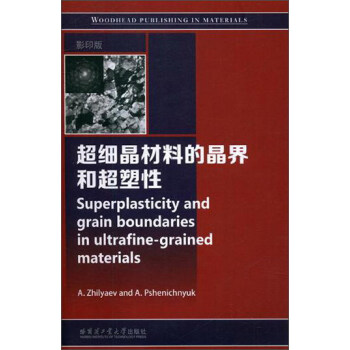精彩书摘:
《超细晶材料的晶界和超塑性(影印版 英文版)》:
3.The set of the parameters characterising the material(the meangrain size made dimensionless with respect to the modulus of the Burgers vector,the shear modulus and the activation energy of grainboundary diffusion,or some effective diffusion in the Gittus model(30) is not completely determined because many essentially differentmaterials are defined by this set as identical.Adding to the set theparameter m which differs from l/2(i.e.,from the value determined bythe models)not only transforms the model to a phenomenological one,and this is done without arguments.but also directly contradicts thecharacteristics of the micromechanisms used as the basis of the model.
……
内容简介:
《超细晶材料的晶界和超塑性(影印版 英文版)》讨论了多晶体材料中超塑性和晶界滑动的问题,探讨了晶界形成和演化的微观结构,分析了经过剧烈塑性变形的材料的晶界、纹理和系综的变化,同时考察了晶界在晶粒间界扩散、弛豫和晶粒生长过程中的作用。
《超细晶材料的晶界和超塑性(影印版 英文版)》适合从事超塑性研究的相关人员使用,也可供高等院校相关专业的师生参考。
目录:
Contents
INTRODUCTION
1 STRUCTURAL SUPERPLASTICITY OF POLYCRYSTALLINE MATERIALS
1.1. Structural levels, spatial scales and description levels
1.2. Structural superplasticity: from the combination of mechanisms to cooperative grain boundaries sliding
1.3. Structural superplasticity: from meso-description to macroeharacteristics
References
2 CHARACTERISTICS OF GRAIN BOUNDARY ENESEMBLES
2.1. Crystal geometry and structure of intercrystalline boundaries
2.1.1. Methods for describing the structure of the grain boundaries
2.1.2. Analytical representation of the basis of the coincident-site lattice for cubic lattices
2.2. Special grain boundaries in the monoclinic lattice
2.3. Description of the grain boundary misorientation distribution (GBMD)
2.4. Computer model of a polycrystal: a calculation algorithm
References
3 ORIENTATION-DISTRIBUTED PARAMETERS OF THE POLYCRYSTALLINE STRUCTURE
3.1. The distribution function of the grains with respect to crystallographic orientations: calculation methods
3.2. Relationship between the grain boundary misorientation distribution and the ODF
3.3. Correlation orientation of adjacent grains: the concept of the basis spectra of misorientation of the grain boundaries
3.4. Modelling the misorientation spectra of the grain boundaries in the FCC crystals with modelling ODF
References
4 EXPERIMENTAL INVESTIGATIONS OF GRAIN BOUNDARY ENSEMBLES IN POLYCRYSTALS
4.1. Diffraction methods of measuring misorientation
4.1.1. Methods of measuring the misorientation of two adjacent grains
4.1.2. The experimental measurement error
4.2. Experimental spectra of the grain boundaries in FCC polycrystals
4.3. Orientation distribution function in Ni-Cr alloy: experimental and modelling GBMDs
4.3.1. Orientation distribution function in Ni-Cr alloy and stainless steels
4.3.2. Modelling spectra of the misorientation of the grain boundaries in Ni-Cr alloy and AISI stainless steels: comparison with the experimental results
4.4. Special features of the grain boundaries in the FCC materials with a high stacking fault energy
4.4.1. Rolling and annealing texture of aluminium
4.4.2. Grain boundary ensembles in aluminium: experiments and modelling
References
5 GRAIN BOUNDARY SLIDING IN METALLIC BI- AND TRICRYSTALS
5.1. Dislocation nature of grain boundary sliding (GBS)
5.2. Formulation of the model of stimulated grain boundary sliding
5.3. Formal solution and its analysis
5.4. Special features of pure grain boundary sliding
5.5. Local migration of the grain boundary as the mechanism of reorganisation of the triple junction: weak migration approximation
5.6. Variance formulation of the system of equations for the shape of the boundary and pile-up density
5.7. The power of pile-ups of grain boundary dislocations
References
6 PERCOLATION MECHANISM OF DEFORMATION PROCESSES IN ULTRAFINE-GRAINED POLYCRYSTALS
6.1. Percolation mechanism of the formation of a band of cooperative grain boundary sliding
6.2. Conditions of formation of CGBS bands as the condition of realisation of the superplastic deformation regime
6.3. Shear rate along the CGBS band
6.4. Kinetics of deformation in CGBS bands
6.5. Comparison of the calculated values with the experimental results
References
7 PERCOLATION PROCESSES IN A NETWORK OF GRAIN BOUNDARIES IN ULTRAFINE-GRAINED MATERIALS
7.1. Effect of grain boundaries on oxidation and diffusion processes in polycrystalline oxide films
7.2. High-resolution electron microscopy of zirconium oxide: grain clusters, surrounded only by special boundaries
7.3. Effect of the statistics of the grain boundaries on diffusion in zirconium oxide
7.4. Special features of oxidation kinetics under the effect of stresses at the metal/oxide boundary
7.5. Texture and spectrum of misorientation of the grain boundaries in an NiO film on (100) and (111) substrates: modelling and experiments
References
8 MICROSTRUCTURE AND GRAIN BOUNDARY ENSEMBLES IN ULTRAFINE-GRAINED MATERIALS
8.1. Methods of producing ultrafine-grained and nanostructured materials by severe plastic deformation
8.2. Effect of the parameters of quasi-hydrostatic pressure on the microstructure and grain boundary ensembles in nickel
8.3. Spectrum of misorientation of grain boundaries in ultrafine-grained nickel
8.4. Advanced methods of automatic measurement of the grain boundary parameters
8.5. The misorientation distribution of the grain boundaries in ultrafine-grained nickel: experiments and modelling
References
9 GRAIN BOUNDARY PROCESSES IN ULTRAFINE-GRAINED NICKEL AND NANONICKEL
9.1. Grain growth kinetics in ECAP specimens
9.2. Activation energy and stored enthalpy in ultrafine-grained nickel
9.3. Evolution of the microstructure and texture in HPT nickel in annealing
9.4. Superplasticity of nanocrystalline nickel
References
10 DURATION OF THE STABLE FLOW STAGE IN SUPER]PLASTIC DEFORMATION
10.1. Superplastic capacity and the rate sensitivity parameter
10.2. Description of thickness differences of a flat specimen in tensile deformation
10.3. Formation of thickness difference as a random process
10.4. Absorption condition and the equation for limiting strain
10.5. Some properties of limiting strain
References
11 DERIVATION OF CONSTITUTIVE EQUATIONS IN MULTICOMPONENT LOADING CONDITIONS
11.1. From the deformation mechanism to constitutive equations
11.2. Kinematics of polycrystalline continuum
11.3. Strain rate tensor determined by shear along the CGBS bands
11.4. Degenerate cases and variants of coaxiality of the tensors
References
CONCLUSION
INDEX




好评度